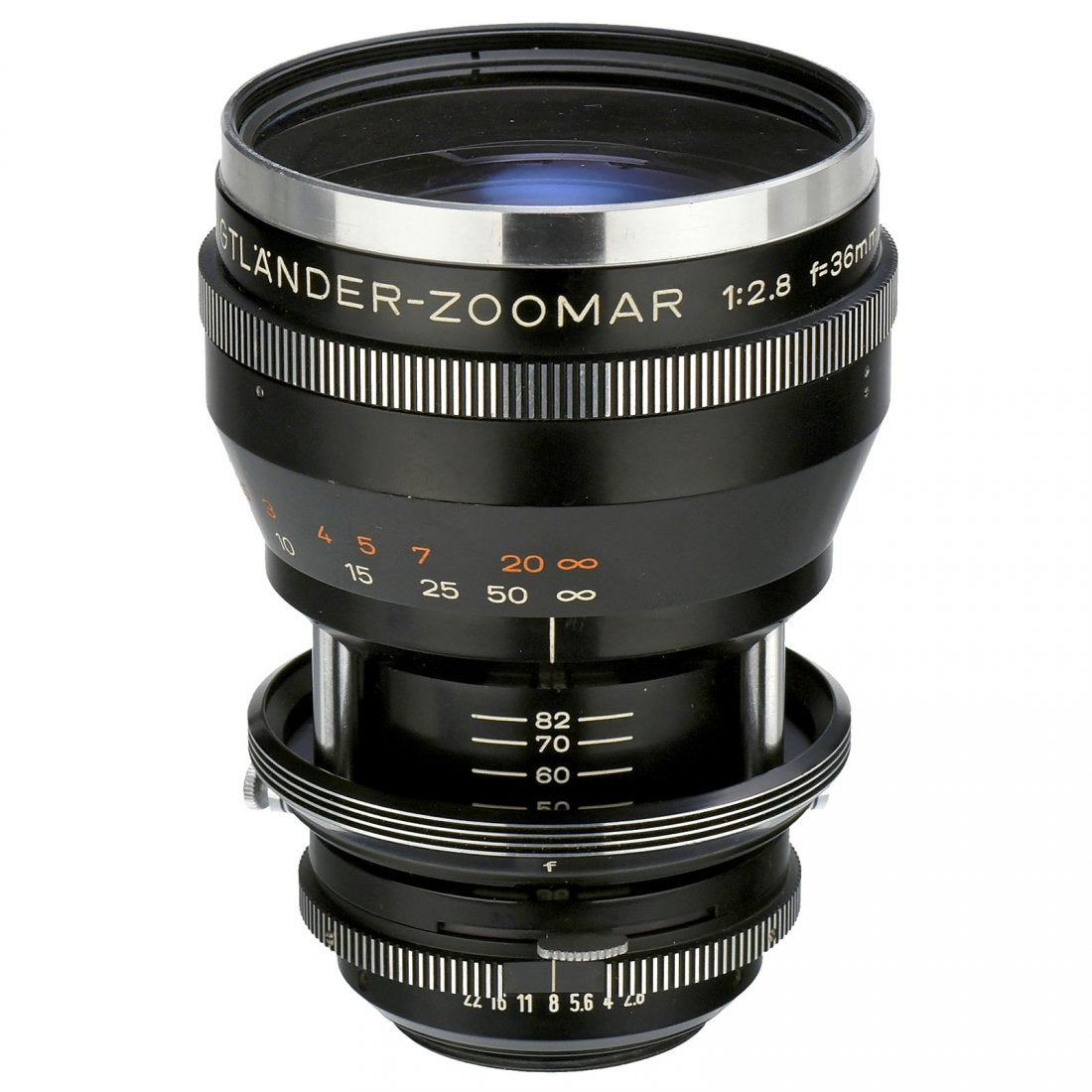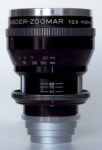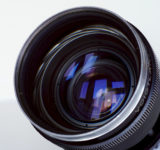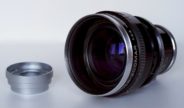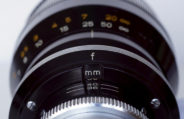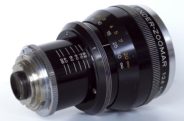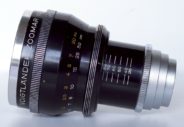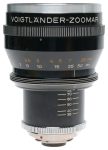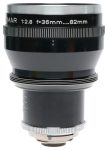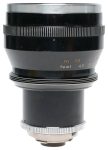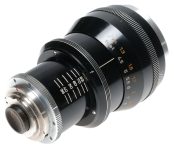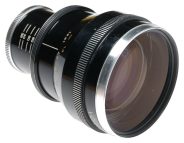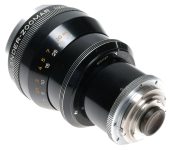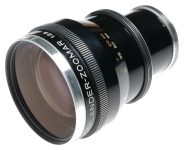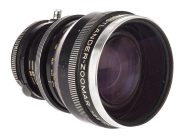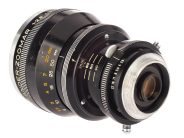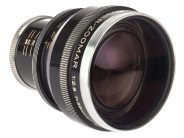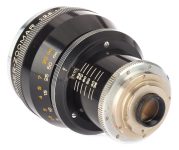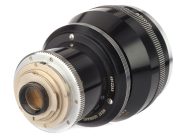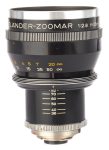Voigtlander-Zoomar 36-82mm F/2.8
Standard zoom lens • Film era • Discontinued
Model history (2)
| ■Voigtlander-Zoomar 36-82mm F/2.8 • Push/pull | A | 14 - 11 | 1.30m | 1959 ● | ||
| ■Voigtlander-Zoomar 36-82mm F/2.8 • Push/pull | A | 14 - 11 | 1.30m | 1968 ● | ||
Features highlight

Specification
| Production details: | |
| Announced: | May 1959 |
| Production status: | ● Discontinued |
| Original name: | VOIGTLÄNDER-ZOOMAR 1:2.8 f=36....82mm |
| System: | - |
| Optical design: | |
| Focal length range: | 36mm - 82mm [2.3X zoom ratio] |
| Speed range: | F/2.8 across the focal length range |
| Maximum format: | 35mm full frame |
| Mount and Flange focal distance: | Deckel [45.7mm] |
| Exakta [44.7mm] | |
| M42 [45.5mm] | |
| Diagonal angle of view: | 62° @ 36mm - 29.5° @ 82mm |
| Lens construction: | 14 elements in 11 groups |
| Diaphragm mechanism: | |
| Diaphragm type: | Automatic |
| Aperture control: | None; the aperture is controlled from the camera (Deckel) |
| Aperture ring (Manual settings only) (Exakta, M42) | |
| Number of blades: | 7 (seven) |
| Zooming: | |
| Zoom mechanism: | Manual |
| Zoom control: | Zoom ring |
| Zoom type: | Push/pull (36mm → 82mm) |
| Zooming method: | Internal zooming |
| Focusing: | |
| Closest focusing distance: | 1.3m |
| Magnification ratio: | <No data> |
| Focusing modes: | Manual focus only |
| Manual focus control: | Focusing ring |
| Physical characteristics: | |
| Weight: | 869g (Deckel) |
| Maximum diameter x Length: | ⌀90×135mm (Deckel) |
| Accessories: | |
| Filters: | <No data> |
| Lens hood: | 305/95 - Screw-type round (with adapter 296/95) |
| Teleconverters: | Not compatible |
| Source of data: | |
| Voigtlander Zoomar 1:2,8 f=36mm..82mm for Bessamatic instructions. | |
Manufacturer description #1
From the Wards 1959 camera shop:
VOIGTLANDER-ZOOMAR Lens For Single-Lens Reflex Cameras... the lens that lets you approach or recede from your subject, without moving a step! Here, in one lens, you have the equivalent of thousands of dollars worth of conventional optics. You have at your fingertips a wide-angle lens, a normal lens and a moderately long-focus lens, but in addition, you have every possible focal length in between... all in one lens!
Vital Statistics: (1) Focal Length: continuously variable from 35 to 80mm, marked on barrel: 35, 40, 50, 60, 70 and 80 mm by simply moving focusing ring. (2) Lens speed: f/2.8. Iris pre-set ring is marked in stops from f/2.8 to f/22. (3) Focusing Range: 4 1/2 ft. to inf. (4) Focusing Scale: Marked on focusing ring for 4 1/2, 5, 6, 10, 15, 25, 50 ft. and inf. (5) Lens Attachments: Front end of Zoomar is internally threaded to accept accessories. (6) Optical Elements: Includes 3 stationary groups and 2 movable groups; movement of these lenses is linear, without cams or gears. (7) Automatic Diaphragm: couples internally to Bessamatic, externally to other single-lens reflex cameras.
Zoomar Lens for Alpa, Asahiflex, Exakta, Miranda and Praktica Cameras. Requires Factory fitting of lens to camera.
LENS-DB: The minimum and maximum focal lengths should be 36 and 82mm respectively, not 35mm and 80mm.
Manufacturer description #2
The Voigtlander-Zoomar is the only Zoomar lens for still cameras. This model, with fully automatic diaphragm, is designed expressly for use with the Bessamatic Camera. A high-precision varifocal lens, in focus at all focal lengths from 36 to 82mm, it enables the photographer to shoot continuously at variable focal lengths without changing camera position. Simple, positive setting with lens ring.
Manufacturer description #3
With the Voigtlander Zoomar, you open up new fields of application in all situations in which you need to be able to vary the field of view without changing your own working position. This lens has a working range of 36 to 82mm. Merely by sliding a ring on the lens mount forward or away from the camera, you can set any intermediate focal length you desire from wide-angle to telephoto. Thus, with this lens you embrace the three most popular focal lengths of 35, 50 and 80mm in one self-contained optical and mechanical unit. The changing of the field of view is smooth and continuous so that you can stop at any intermediate point in the range from 36 to 82mm. While doing this, your exposure and distance settings remain constant. You can take flash shots continuously without having to make any changes in the camera controls.
From the Popular Photography magazine (May 1962)
VOIGTLANDER-ZOOMAR, 36-82-mm. Forerunner of the group - an optically compensated, 14-element, f/2.8 lens introduced in 1959 in two models.
Model For Voigtlander Bessamatic, leaf-shutter 35: Has automatic diaphragm that couples to camera's built-in follow-pointer exposure meter. Winding film after exposure reopens lens to full aperture and permits viewing through pentaprism. Aperture range: f/2.8-f/22. Zooming: choice of continuously variable focal lengths by back or forth motion of special zoom ring. Marked focal lengths: 36, 40, 50, 60, 70, and 82-mm. Zooming does not increase length of lens. Focusing: by separate ring down to 4 1/2 ft.; with screw-in supplementary lenses, at closer distances down to 10 in. Distances down to 4 1/2 ft. given in feet and meters. Length: with lens at infinity, 4 3/4 in. Weight: 1 3/4 lbs. Made in West Germany.
Model for numerous focal-plane, single-lens reflex 35's: Basically same as lens described above. (See Aperture range, Zooming, Focusing, Length and Weight.) Semi-automatic model, easily identifiable by cable release fitting that connects lens diaphragm and camera, and by cocking lever on lens, which is actuated manually after exposure to open diaphragm to full aperture. Should be installed by qualified repairman, using proper adapter kit containing adapter ring and cable release fitting. Kits are available from dealers for the following cameras: Alpa, Edixa, Exa, Exakta, Konicaflex, Minolta SR 1, SR 2, SR 3, Miranda, Pentax, Pentacon, Petri Penta, Praktica, Topcon, and Yashica Pentamatic and Pentamatic S (using the Exakta kit, and a Yashica adapter available through Yashica dealers). Importer of Voigtlander-Zoomar lenses: H.A. Bohm, & Co., 2814 W. Peterson Ave., Chicago 45, Ill.
From the editor
Designed by Dr. Frank G.Back and produced by Voigtlander in Germany, the 1959 36-82/2.8 Zoomar was the world's first production zoom for 35mm still cameras. Dr. Back and Zoomar had previously produced Zooms for TV and movie cameras. Looking back today, it's amazing how much he got right from the start. Dr. Back succeeded in obtaining a very useful wide to short tele zoom range, with a fast 2.8 aperture and a convenient single zoom control ring. He not only invented the lens, he invented the term "Zoom" as it applies to 35mm lenses. Prophetically, the 36-82 was introduced to America at the Philadelphia camera show that also introduced the Nikon F and Canon Canonflex to the American public.
Today collectors usually associate the 36-82/2.8 Zoomar with Voigtlander's excellent leaf shutter Bessamatic SLR. Actually the Zoomar was introduced from day one in both Voigtlander Bessamatic and Exakta mounts. Later it was also produced in other mounts, including 42mm screw mount. It was introduced in May 1959, but not generally available until 1960. Optically, the Zoomar 36-82 was a great breakthrough, made possible according to Dr. Back by new rare earth element glasses and computer aided optical designs. 14 elements in 11 groups, focusing with front element. Groups 2, 3 and 6 move lineary together for focal length change. All elements have a simple anti-reflex coating. Standard close focus is 4 1/2 feet, but two close up lenses were available - the Focar A and B - which provided focus as close as 10 inches.
Filters, Focar lenses and the collapsible rubber lens hood are attached to the lens with the aid of the clamping ring 296/95. Assembly: Clamp the ring to the front lens mount and screw the accessory into the inner screw thread of the ring (95mm diameter). Several attachments can of course be combined.
Lenses with similar focal length range
Sorted by manufacturer name
| ■M42 mount (3) | |||||||||
| Sigma-XQ MF 39-80mm F/3.5 | A | 12 - 10 | 2.00m | ⌀62 | 1975 ● | ||||
| Sigma MF 35-85mm F/2.8-4 | A | 11 - 9 | 0.50m | ⌀52 | 1980 ● | ||||
| Vivitar Series 1 35-85mm F/2.8 Auto VMC (s/n 22xxxxxx) • Push/pull | A | 12 - 9 | 0.26m | ⌀72 | 1974 ● | ||||
| ■Interchangeable mount (2) | |||||||||
| Tamron SP 35-80mm F/2.8-3.8 01A [Adaptall-2] | A | 9 - 8 | 0.27m | ⌀62 | 1979 ● | ||||
| Tamron 35-80mm F/2.8-3.5 QZ-35M [Adaptall] • Push/pull | A | 13 - 13 | 1.30m | ⌀62 | 1978 ● | ||||
